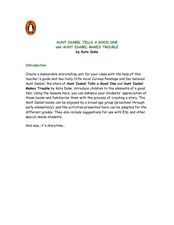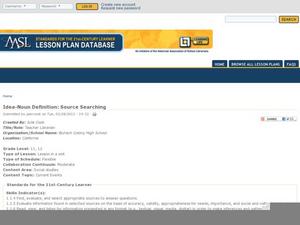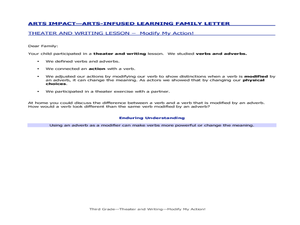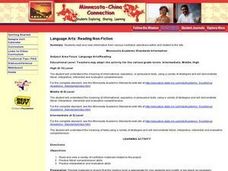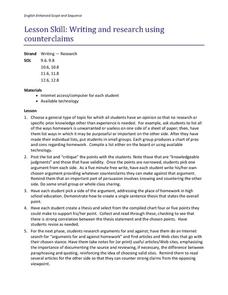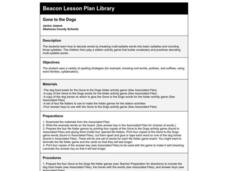Curated OER
Language Arts: Telling a Painting's Story
Use art museum paintings as inspiration for your class's creative writing works. Observing the paintings closely, middle and high schoolers list details and write descriptions. Their completed stories are displayed on bulletin boards...
Curated OER
Looking Back - An Art/English/History Interdisciplinary Unit
Students research historical events of the past century to recognize that society impacts the themes within art and literature. They then interview an individual to develop a biographical narrative, a collage and finally an oral...
Curated OER
Aunt Isabel Tells a Good One...
Explore language arts by reading two similar stories in order to compare and contrast them in class. Young readers read two Aunt Isabel books, by Kate Duke, and discuss the main characters, plot, and setting. They complete a graphic...
Curated OER
Theater Lesson: Modify My Action
Young scholars engage in a lesson that is about the meaning of a verb or adverb. They perform sketches with the subject matter of the words. The goal is for the actors to show the meaning of the verb or adverb with an action.
Curated OER
Language Arts: Conversing with an Object
Students sharpen their creative writing skills by writing dialogues with unfamiliar objects while visiting local museums. They select an object in the museum, such as a painting, and create conversations between the people or animals...
Curated OER
Language Arts: Telling Your Story
Learners use information from a visit to an historical exhibition to write stories about someone who lived during that time period.. They use handouts to record information to use in their writings. Students choose identities, real or...
Curated OER
Idea-Noun Definition: Source Searching
A great idea for showing language arts pupils the universality of themes, even in the real world! Have class members choose an idea-noun (peace, justice, war, love, etc.) at the beginning of the year or semester. They complete weekly...
Curated OER
What Do You See at the Pond?
With What Do You See at the Pond?, young readers explore pond life and practice reading strategies. Learners first make predictions and then read the simple story independently. After a second read-through with a partner, kids come...
EngageNY
Science Talk: How do Bullfrogs Survive
Following the reading of the book Bullfrog at Magnolia Circle, the ninth lesson in this unit involves emerging experts in a science talk about how bullfrogs survive. Looking back through the text, young scholars prepare for the...
Curated OER
Modify My Action
Third graders listen to directions as they perform a theatrical role. In this vocabulary lesson plan, 3rd graders listen to and observe the adjectives given to them during a practice of their performance by the director....
Curated OER
Home in the Desert: Lesson for Use with This House is Made of Mud
Third graders examine how a family modifies their environment to create a home out of mud. They read the book "This House is Made of Mud" by Ken Buchanan, and write a description of their own home that compares the home of mud to their...
Curated OER
Graphic Organizer: Research Note Taking Made Easy
What do you wonder about bats? Use an open-ended question like this to engage your class and interest them in an upcoming research project. There's a list of example questions to offer or suggest regarding bats, but see what they can...
Curated OER
A Better Class of Journal-ists
Young academics create a current events journal by skimming newspapers for articles that fit defined guidelines for informational texts. After cutting out two articles each week to add to their journals, they write a brief description of...
Curated OER
Writing a Character Sketch
Combining descriptive and expository writing skills, middle schoolers create a character sketch about someone they know well. They use a graphic organizer to help them discuss a model character sketch and organize/write one of their own....
Curated OER
Rhythm and Art: Elements of Art
Students discover the three elements of art. In this visual arts lesson, students examine line, shape, and color of works by Torres-Garcia and Picasso. Students then identify the elements of art in works by other artists.
Curated OER
Visualization: Cricket in Times Square
After reading The Cricket in Times Square chapter titled "Caught in the Kitchen," learners list three describing details about the characters and setting. Groups collaborate to find sensory details to support their character assertions....
Curated OER
Inventions in Everyday Life
Students identify and solve problems as they modify the design of an everyday household item. They gather and analyze information and work in collaborative teams to create a design plan for a new product.
Curated OER
Language Arts: Reading Non-Fiction
Students read and view information sent from seven high school students who travel to China. The daily reports that they send back to the weblog section of the site should be of high interest to students in Minnesota.
Curated OER
Hamlet's State of Mind
Analyze various excerpts from Hamlet and read articles to develop an argument about his sanity. Middle and high schoolers write an argument essay defending whether or not they believe Hamlet is insane. You could modify this assignment...
Virginia Department of Education
Writing and Research Using Counterclaims
Introduce your high school scholars as to how to use counterclaims in argument writing. Learners explore this skill with collaborative efforts and technology. Together they explore the pros and cons of homework and develop a thesis for...
Curated OER
Persuasive Speech Assignment
Practice using concrete evidence from various sources to back up an argument. The lesson emphasizes the use of support in a persuasive speech, as well as the importance of appealing to an audience's logic and emotions. You could modify...
Curated OER
The Amazing Maud Lewis
Students investigate cultural art from Canada by reading about Maud Lewis. In this Canadian history lesson, students identify the work of Lewis by visiting her magazine website. Students identify other heroes in Nova Scotia...
Curated OER
Poetry Interpretation and Figurative Language
Fifth graders discover how figurative language is used in poetry. They read selected poems and identify the figurative language with handouts and worksheets included in the lesson. They write poems of their own using figurative language.
Curated OER
Gone to the Dogs
Approach vocabulary through decoding and chunking. Your class breaks up words into basic syllables or chunks then engages in a decoding activity. Useful for a variety of language levels and grades, just modify to fit your class.


